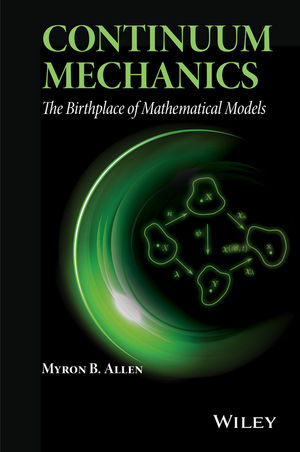
Continuum Mechanics
John Wiley & Sons Inc (Verlag)
978-1-118-90937-9 (ISBN)
Presents a self-contained introduction to continuum mechanics that illustrates how many of the important partial differential equations of applied mathematics arise from continuum modeling principles
Written as an accessible introduction, Continuum Mechanics: The Birthplace of Mathematical Models provides a comprehensive foundation for mathematical models used in fluid mechanics, solid mechanics, and heat transfer. The book features derivations of commonly used differential equations based on the fundamental continuum mechanical concepts encountered in various fields, such as engineering, physics, and geophysics.
The book begins with geometric, algebraic, and analytical foundations before introducing topics in kinematics. The book then addresses balance laws, constitutive relations, and constitutive theory. Finally, the book presents an approach to multiconstituent continua based on mixture theory to illustrate how phenomena, such as diffusion and porous-media flow, obey continuum-mechanical principles.
Continuum Mechanics: The Birthplace of Mathematical Models features:
Direct vector and tensor notation to minimize the reliance on particular coordinate systems when presenting the theory
Terminology that is aligned with standard courses in vector calculus and linear algebra
The use of Cartesian coordinates in the examples and problems to provide readers with a familiar setting
Over 200 exercises and problems with hints and solutions in an appendix
Introductions to constitutive theory and multiconstituent continua, which are distinctive for books at this level
Continuum Mechanics: The Birthplace of Mathematical Models is an ideal textbook for courses on continuum mechanics for upper-undergraduate mathematics majors and graduate students in applied mathematics, mechanical engineering, civil engineering, physics, and geophysics. The book is also an excellent reference for professional mathematicians, physical scientists, and engineers.
Myron B. Allen, PhD, is Professor of Mathematics at the University of Wyoming, Consulting Editor for Wiley's Pure and Applied Mathematics book series, and past provost and vice president for Academic Affairs. His research interests include numerical analysis, mathematical modeling, and fluid mechanics in porous media.
Preface v
1 Geometric Setting 1
1.1 Vectors and Euclidean Point Space 2
1.1.1 Vectors 2
1.1.2 Euclidean Point Space 6
1.1.3 Summary 8
1.2 Tensors 8
1.2.1 First-Order Tensors and Vectors 8
1.2.2 Second-Order Tensors 11
1.2.3 Cross Products, Triple Products, and Determinants 15
1.2.4 Orthogonal Tensors 20
1.2.5 Invariants of a Tensor 21
1.2.6 Derivatives of Tensor-Valued Functions 24
1.2.7 Summary 27
2 Kinematics I: The Calculus of Motion 29
2.1 Bodies, Motions, and Deformations 29
2.1.1 Deformation 32
2.1.2 Examples of Motions 33
2.1.3 Summary 36
2.2 Derivatives of Motion 36
2.2.1 Time Derivatives 37
2.2.2 Derivatives with Respect to Position 38
2.2.3 The Deformation Gradient 40
2.2.4 Summary 42
2.3 Pathlines, Streamlines, and Streaklines 43
2.3.1 Three Types of Arc 43
2.3.2 An Example 45
2.3.3 Summary 49
2.4 Integrals Under Motion 49
2.4.1 Arc, Surface, and Volume Integrals 49
2.4.2 Reynolds Transport Theorem 55
2.4.3 Summary 57
3 Kinematics II: Strain and its Rates 59
3.1 Strain 59
3.1.1 Symmetric Tensors 60
3.1.2 Polar Decomposition and the Deformation Gradient 64
3.1.3 Examples 66
3.1.4 Cauchy–Green and Strain Tensors 68
3.1.5 Strain Invariants 70
3.1.6 Summary 71
3.2 Infinitesimal Strain 72
3.2.1 The Infinitesimal Strain Tensor 72
3.2.2 Summary 75
3.3 Strain Rates 75
3.3.1 Stretching and Spin Tensors 76
3.3.2 Skew Tensors, Spin, and Vorticity 79
3.3.3 Summary 84
3.4 Vorticity and Circulation 84
3.4.1 Circulation 84
3.4.2 Summary 88
3.5 Observer Transformations 89
3.5.1 Changes in Frame of Reference 89
3.5.2 Summary 95
4 Balance Laws 97
4.1 Mass Balance 98
4.1.1 Local Forms of Mass Balance 99
4.1.2 Summary 102
4.2 Momentum Balance 102
4.2.1 Analysis of Stress 104
4.2.2 Inertial Frames of Reference 110
4.2.3 Momentum Balance in Referential Coordinates 113
4.2.4 Summary 114
4.3 Angular Momentum Balance 115
4.3.1 Symmetry of the Stress Tensor 117
4.3.2 Summary 118
4.4 Energy Balance 119
4.4.1 Thermal Energy Balance 122
4.4.2 Summary 124
4.5 Entropy Inequality 124
4.5.1 Motivation 125
4.5.2 Clausius–Duhem Inequality 126
4.5.3 Summary 127
4.6 Jump Conditions 127
4.6.1 Singular Surfaces 129
4.6.2 Localization 132
4.6.3 Summary 135
5 Constitutive Relations: Examples of Mathematical Models 137
5.1 Heat Transfer 138
5.1.1 Properties of the Heat Equation 140
5.1.2 Summary 142
5.2 Potential Theory 143
5.2.1 Motivation 143
5.2.2 Boundary Conditions 144
5.2.3 Uniqueness of Solutions to the Poisson Equation 146
5.2.4 Maximum Principle 147
5.2.5 Mean Value Property 150
5.2.6 Summary 151
5.3 Fluid Mechanics 152
5.3.1 Ideal Fluids 152
5.3.2 An Ideal Fluid in a Rotating Frame of Reference 154
5.3.3 Acoustics 155
5.3.4 Incompressible Newtonian Fluids 158
5.3.5 Stokes Flow 159
5.3.6 Summary 163
5.4 Solid Mechanics 164
5.4.1 Static Displacements 164
5.4.2 Elastic Waves 167
5.4.3 Summary 170
6 Constitutive Theory 173
6.1 Conceptual Setting 174
6.1.1 The Need to Close the System 174
6.1.2 Summary 176
6.2 Determinism and Equipresence 177
6.2.1 Determinism 177
6.2.2 Equipresence 177
6.2.3 Summary 178
6.3 Objectivity 179
6.3.1 Reducing Functional Dependencies 180
6.3.2 Summary 182
6.4 SYMMETRY 183
6.4.1 Changes in Reference Configuration 183
6.4.2 Symmetry Groups 186
6.4.3 Classification of Materials 189
6.4.4 Implications for Thermoviscous Fluids 193
6.4.5 Summary 193
6.5 Admissibility 194
6.5.1 Implications of the Entropy Inequality 195
6.5.2 Analysis of Equilibrium 197
6.5.3 Linear, Isotropic, Thermoelastic Solids 199
6.5.4 Summary 202
7 Multiconstituent Continua 203
7.1 Constituents 204
7.1.1 Configurations and Motions 204
7.1.2 Volume Fractions and Densities 206
7.1.3 Summary 208
7.2 Multiconstituent Balance Laws 209
7.2.1 Multiconstituent Mass Balance 210
7.2.2 Multiconstituent Momentum Balance 212
7.2.3 Multiconstituent Angular Momentum Balance 214
7.2.4 Multiconstituent Energy Balance 215
7.2.5 Multiconstituent Entropy Inequality 216
7.2.6 Isothermal, Nonreacting Multiphase Mixtures 217
7.2.7 Summary 219
7.3 Fluid Flow in a Porous Solid 220
7.3.1 Modeling Assumptions for Porous Media 221
7.3.2 Balance Laws for the Fluid and Solid Phases 223
7.3.3 Equilibrium Constraints 225
7.3.4 Linear Extensions From Equilibrium 226
7.3.5 Commentary 228
7.3.6 Potential Formulation of Darcy’s Law 229
7.3.7 Summary 233
7.4 Diffusion in a Binary Fluid Mixture 234
7.4.1 Modeling Assumptions for Binary Diffusion 235
7.4.2 Balance Laws for the Two Species 235
7.4.3 Constitutive Relationships for Diffusion 236
7.4.4 Modeling Solute Transport 239
7.4.5 Summary 242
A Guide to Notation 243
A.1 General Conventions 243
A.2 Letters Reserved for Dedicated Uses 244
A.3 Special Symbols 245
B Vector Integral Theorems 247
B.1 Stokes’s Theorem 248
B.2 The Divergence Theorem 249
B.3 The Change-of-variables Theorem 252
C Hints and Solutions to Exercises 253
References 265
Index 269
| Erscheint lt. Verlag | 11.8.2015 |
|---|---|
| Verlagsort | New York |
| Sprache | englisch |
| Maße | 165 x 241 mm |
| Gewicht | 649 g |
| Themenwelt | Mathematik / Informatik ► Mathematik ► Analysis |
| Mathematik / Informatik ► Mathematik ► Angewandte Mathematik | |
| Naturwissenschaften ► Physik / Astronomie ► Mechanik | |
| Technik ► Elektrotechnik / Energietechnik | |
| Technik ► Maschinenbau | |
| ISBN-10 | 1-118-90937-2 / 1118909372 |
| ISBN-13 | 978-1-118-90937-9 / 9781118909379 |
| Zustand | Neuware |
| Informationen gemäß Produktsicherheitsverordnung (GPSR) | |
| Haben Sie eine Frage zum Produkt? |
aus dem Bereich


